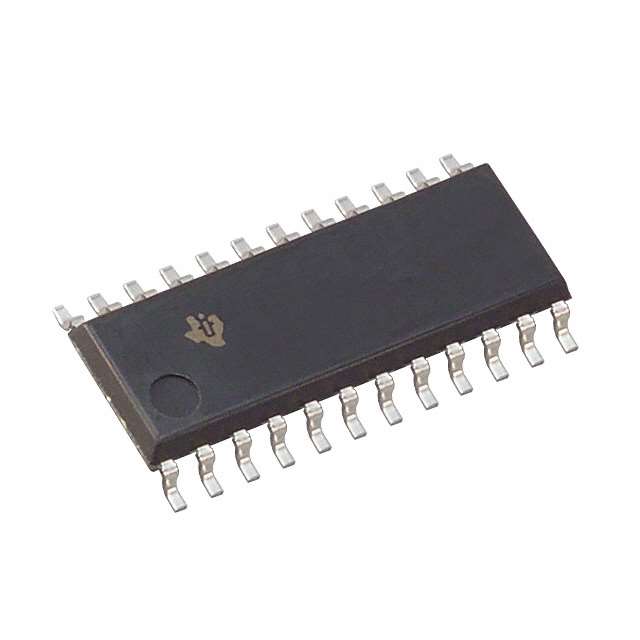SN74LVC646ANSRE4
Product Overview
- Category: Integrated Circuit
- Use: Level Shifter and Bus Transceiver
- Characteristics: High-speed, low-voltage, CMOS technology
- Package: SOIC (Small Outline Integrated Circuit)
- Essence: Transfers data between different voltage domains
- Packaging/Quantity: Tape and Reel, 2500 units per reel
Specifications
- Supply Voltage Range: 1.65V to 3.6V
- Input Voltage Range: 0V to VCC
- Output Voltage Range: 0V to VCC
- Maximum Operating Frequency: 100MHz
- Number of Channels: 8
- Input/Output Type: Tri-State
- Propagation Delay: 2.5ns (Max)
- Operating Temperature Range: -40°C to +85°C
Detailed Pin Configuration
The SN74LVC646ANSRE4 has a total of 24 pins. The pin configuration is as follows:
- OE (Output Enable) 1
- A1 (Data Input/Output) 1
- B1 (Data Input/Output) 1
- A2 (Data Input/Output) 2
- B2 (Data Input/Output) 2
- A3 (Data Input/Output) 3
- B3 (Data Input/Output) 3
- A4 (Data Input/Output) 4
- B4 (Data Input/Output) 4
- GND (Ground)
- OE (Output Enable) 2
- DIR (Direction Control)
- VCC (Supply Voltage)
- B4 (Data Input/Output) 4
- A4 (Data Input/Output) 4
- B3 (Data Input/Output) 3
- A3 (Data Input/Output) 3
- B2 (Data Input/Output) 2
- A2 (Data Input/Output) 2
- B1 (Data Input/Output) 1
- A1 (Data Input/Output) 1
- OE (Output Enable) 1
- GND (Ground)
- VCC (Supply Voltage)
Functional Features
- Level shifting between different voltage domains
- Bidirectional data transfer capability
- Tri-State outputs for bus sharing
- High-speed operation
- Low power consumption
- ESD protection on all inputs and outputs
Advantages and Disadvantages
Advantages: - Supports a wide range of supply voltages - Allows interfacing between systems with different voltage levels - Provides bidirectional communication between devices - Offers protection against electrostatic discharge (ESD) - Compact package size for space-constrained applications
Disadvantages: - Limited maximum operating frequency compared to some other ICs - Requires careful consideration of voltage compatibility to avoid damage
Working Principles
The SN74LVC646ANSRE4 is designed to facilitate the transfer of data between different voltage domains. It acts as a level shifter and bus transceiver, allowing communication between devices operating at different voltage levels. The direction of data flow can be controlled using the DIR pin. When enabled, the IC allows bidirectional data transfer, while disabling it puts the outputs in a high-impedance state.
Detailed Application Field Plans
The SN74LVC646ANSRE4 finds applications in various fields where level shifting and bus transceiver functionality are required. Some specific application areas include:
Microcontroller Interfacing: The IC enables communication between microcontrollers operating at different voltage levels, facilitating seamless integration of multiple systems.
Industrial Automation: It can be used in industrial automation systems to interface between different control modules, ensuring compatibility and reliable data transfer.
Communication Systems: The IC enables level shifting and bus transceiver functionality in communication systems, allowing seamless integration of devices with varying voltage requirements.
Automotive Electronics: It finds applications in automotive electronics, where it facilitates communication between different subsystems operating at different voltage levels.
Detailed and Complete Alternative Models
- SN74LVC245A: Octal Bus Transceiver with 3-State Outputs
- SN74LVC4245A: Octal Bus Transceiver and Level Shifter with 3-State Outputs
- SN74LVC8T245: 8-Bit Dual-Supply Bus Transceiver with Configurable Voltage Translation
These alternative models offer similar functionality to the SN74LVC646ANSRE4 and can be considered as alternatives based on specific application requirements.
Word count: 529 words
Lista 10 Vanliga frågor och svar relaterade till tillämpningen av SN74LVC646ANSRE4 i tekniska lösningar
Sure! Here are 10 common questions and answers related to the application of SN74LVC646ANSRE4 in technical solutions:
Q: What is SN74LVC646ANSRE4? A: SN74LVC646ANSRE4 is a high-performance octal bus transceiver and register with 3-state outputs, designed for asynchronous communication between two data buses.
Q: What is the operating voltage range of SN74LVC646ANSRE4? A: The operating voltage range of SN74LVC646ANSRE4 is from 1.65V to 5.5V.
Q: What is the maximum data transfer rate supported by SN74LVC646ANSRE4? A: SN74LVC646ANSRE4 supports a maximum data transfer rate of 400 Mbps.
Q: Can SN74LVC646ANSRE4 be used as a level shifter? A: Yes, SN74LVC646ANSRE4 can be used as a level shifter to convert signals between different voltage levels.
Q: How many data lines can SN74LVC646ANSRE4 handle? A: SN74LVC646ANSRE4 can handle up to 8 bidirectional data lines.
Q: Does SN74LVC646ANSRE4 have built-in ESD protection? A: Yes, SN74LVC646ANSRE4 has built-in ESD protection, which helps protect against electrostatic discharge events.
Q: Can SN74LVC646ANSRE4 be used in both parallel and serial communication systems? A: Yes, SN74LVC646ANSRE4 can be used in both parallel and serial communication systems, thanks to its bidirectional data lines.
Q: What is the power supply current consumption of SN74LVC646ANSRE4? A: The power supply current consumption of SN74LVC646ANSRE4 depends on the operating conditions and load, but it typically ranges from a few microamps to a few milliamps.
Q: Can SN74LVC646ANSRE4 be used in automotive applications? A: Yes, SN74LVC646ANSRE4 is qualified for automotive applications and meets the necessary standards and requirements.
Q: Are there any application notes or reference designs available for SN74LVC646ANSRE4? A: Yes, Texas Instruments provides application notes and reference designs for SN74LVC646ANSRE4, which can help with its implementation in various technical solutions.
Please note that these answers are general and may vary depending on specific use cases and requirements. It's always recommended to refer to the datasheet and consult with the manufacturer for detailed information.


